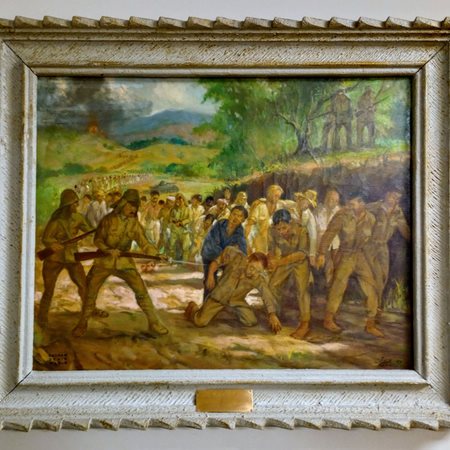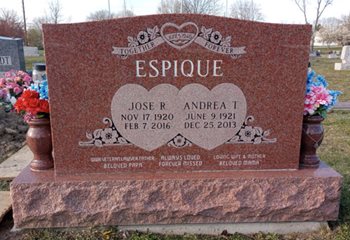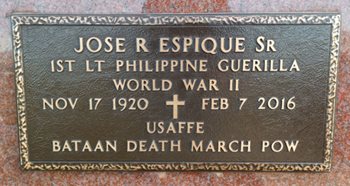By Cathi Taylor, ALA National Headquarters Archivist
Have you ever looked at a piece of art that simply doesn’t resonate with you? No matter how hard you try to appreciate it, the artist’s message just isn’t coming through? You may know what the art piece is about, but for you, it just sits there.
 I found myself feeling that way about a piece of art hanging in the American Legion Auxiliary Cavalcade of Memories Museum. It is a painting given to 1958-1959 National President Cecilia Gunn when she visited the Philippines in 1959. The subject: the Bataan Death March.
I found myself feeling that way about a piece of art hanging in the American Legion Auxiliary Cavalcade of Memories Museum. It is a painting given to 1958-1959 National President Cecilia Gunn when she visited the Philippines in 1959. The subject: the Bataan Death March.
The march began on April 10, 1942, following the Battle of Bataan, when the Japanese gained control of the islands, lasting five grueling days. It was 65 miles of physical abuse and thoughtless killings of both American and Filipino prisoners. Because no records were kept, it is difficult to say how many died. However, based on written accounts, it is estimated that approximately 26,000 Filipinos and 700 U.S. soldiers died during the five-day march and subsequent three-year imprisonment.
I knew the story and watched a documentary about it. I grew up on World War II movies, so the atrocity was familiar to me. And yet, even knowing all of that, I could find no way in which to appreciate this painting. It was too dark, too disturbing, and unimpressive. I was convinced that while I would take care of it, I would never like it. Little did I know that one small event would change my mind.
My American Legion Auxiliary unit decorates a local cemetery for Memorial Day weekend every year. It was a project I could get into. The cemetery office didn’t keep track of the veterans buried there, which meant the volunteers had to walk every row of every section. I offered to not only plot the cemetery so the volunteers could locate the veterans’ graves more readily, but also find those buried there whose service was either not indicated with a military marker or not indicated on their headstone.
 It was on a sunny afternoon last fall that I visited the cemetery and began plotting a section. I walked up and down the rows, jotting down the names, dates, and any other information that would aid my research. As I reached the halfway point in one row, I noticed a large headstone for Jose R. Espique Sr. Beneath his name was engraved “WWII Veteran, Lawyer, Father,” but nothing more about his service. I walked around the headstone, found his military marker, and began jotting down the information when it happened. I froze. My eyes read the last line:
It was on a sunny afternoon last fall that I visited the cemetery and began plotting a section. I walked up and down the rows, jotting down the names, dates, and any other information that would aid my research. As I reached the halfway point in one row, I noticed a large headstone for Jose R. Espique Sr. Beneath his name was engraved “WWII Veteran, Lawyer, Father,” but nothing more about his service. I walked around the headstone, found his military marker, and began jotting down the information when it happened. I froze. My eyes read the last line:
 Espique, a 1st lieutenant Philippine guerilla in the United States Armed Forces of the Far East (USAFFE), was a survivor of that gruesome march and imprisonment.
Espique, a 1st lieutenant Philippine guerilla in the United States Armed Forces of the Far East (USAFFE), was a survivor of that gruesome march and imprisonment. ALA Digital Archive Collection
To learn more about the history of the American Legion Auxiliary, please visit our digital archive collection at https://alaforveterans.pastperfectonline.com.